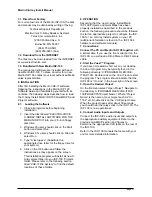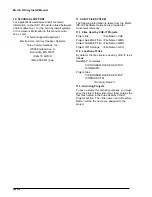
Merlin X-Array Install Manual
page 12
turned off then back on.) Therefore, any
adjustments made to the analog gain structure to
improve the signal-to-noise ratio must be
programmed manually by the user. In addition, any
adjustments made by the user in the analog domain
must be compensated for in the digital domain by
manual programming. The X-Array Install factory
QuickSets assume that the analog inputs and
outputs are set for unity gain (as the ISP-100 is
shipped from the factory).
To maximize the signal-to-noise ratio, the user must
first make sure that the input-signal level is high
enough to use the full dynamic range of the analog-
to-digital converter. This is typically best achieved
by having the ISP-100 analog input gains set for 0
dB (the factory setting). The input signal to the ISP-
100 should be high enough so that instantaneous
program peaks are –5 to –10 dB below clipping.
The signal-to-noise ratio may be further improved
by adjusting both the analog and digital output
gains of the mid-bass- and high-frequency sections.
The mid-bass- and high-frequency sections of the
X-Array Install loudspeaker systems are horn
loaded, making them much more efficient than the
direct-radiating or slot-loaded low-frequency
sections. As a result, the digital gains of the mid-
bass- and high-frequency sections have been
reduced in the factory QuickSets to achieve a
spectral balance with the low-frequency sections.
The signal-to-noise ratio can be improved by
reducing the output gains in the analog domain and
then increasing the output gains in the digital
domain by the same amount. This results in the
same spectral balance, but raises the mid-bass-
and high-frequency signals further out of the noise
floor of the digital-to-analog output section. The
user should note that, whenever the analog output
gains are reduced, the digital limiter thresholds
must be increased by an identical amount to
achieve the same loudspeaker protection. The
following sections describe the procedure for
making adjustments to the gain structure for both
the two-way and three-way systems.
5.3.1 Adjusting the Gain Structure for the Two-
Way Systems
To maximize the signal-to-noise ratio of the two-way
systems, the gain structure of the high-frequency
section may be adjusted from the Vue-It program as
detailed below. Adjustments are not required for the
subwoofer- and low-frequency sections.
1.
Set the high-frequency analog output gains to –8
dB. From the Vue-It program, click on any of the
green input triangles to open the analog gain
menu. Go to the output-gain sub menus for the
high-frequency outputs (outputs 5B and 3B) and
select –8 dB for the output gain.
2.
Increase the high-frequency digital gain in the
“Filters” menu by +8 dB. From the Vue-It
program, click on the “Filters” blocks in the high-
frequency outputs (“Filter_a_High” and
“Filter_b_High”) and, from the menus, increase
the gain by +8 dB above that indicated in the
factory QuickSet.
3.
Increase the high-frequency limiter thresholds
from the “Limiter” menus by +8 dB. From the
Vue-It program click on the “Limiter” blocks in the
high-frequency outputs (“Limiter_a_High” and
“Limiter_b_High”) and, from the menus, increase
the thresholds by +8 dB above that indicated in
the factory QuickSet.
4.
Save your changes. From the Vue-it program,
click on the "Update" button in the QuickSET
Manager panel to save your changes to the
current QuickSET. Then select "Save" from the
File menu to update your entire project to disk.
These adjustments will work with most program
material; however, if “In Processing” clipping occurs
in the digital path of the high-frequency output
section, the gain adjustment can be decreased. For
example, instead of an 8-dB adjustment, a 6-dB
adjustment can be tried. (In other words, set the
analog output gains to –6 dB, then increase the
digital gains by +6 dB and the digital limiter
thresholds by +6 dB.)
5.3.2 Adjusting the Gain Structure for the Three-
Way Systems
To maximize the signal-to-noise ratio of the three-
way systems, the gain structure of the mid-bass-
and high-frequency sections may be adjusted from
the Vue-It program as detailed below. Adjustments
are not required for the subwoofer- and low-
frequency sections.
1. Set the high-frequency analog output gains to –8
dB. From the Vue-It program, click on any one of
the green input triangles to open the analog gain
menu. Go to the output-gain sub menus for the
high-frequency outputs (outputs 4A and 3B) and
select –8 dB for the output gain.
2. Increase the high-frequency digital gain in the
“Filters” menu by +8 dB. From the Vue-It
program, click on the “Filters” blocks in the high-
frequency outputs (“Filter_a_High” and
“Filter_b_High”) and, from the menus, increase
the gain by +8 dB above that indicated in the
factory QuickSet.
3. I
ncrease the high-frequency limiter thresholds
from the “Limiter” menus by +8 dB. From the
Vue-It program click on the “Limiter” blocks in the
high-frequency outputs (“Limiter_a_High” and
“Limiter_b_High”) and, from the menus, increase
the thresholds by +8 dB above that indicated in
the factory QuickSet.





































